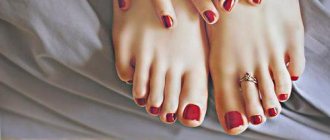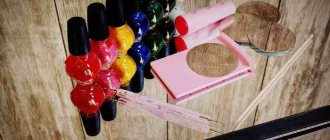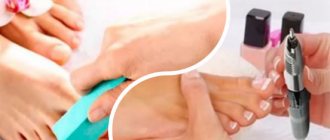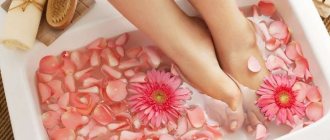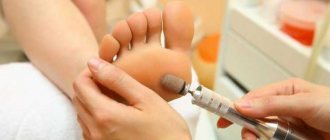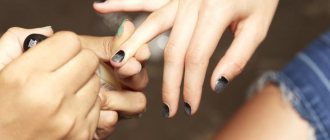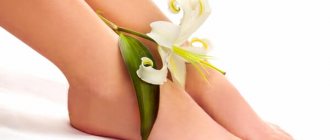Nail care is an important part of a girl’s daily life, in which they mainly focus on the condition of the hands and manicure, since the hands and their condition are always visible. Because of this, pedicures are usually performed only in the warm season, when wearing open shoes and visiting beaches and swimming pools becomes common.
Because of this, the question of how to do a hardware pedicure at home is becoming common, as women often strive to do it themselves in order to save time on visiting the salon and reduce the price of the technique.
What is a hardware pedicure
Nowadays, professional hardware pedicures are performed in almost all salons, since using a special device for removing cuticles is the safest and most effective method. After visiting the salon, dry skin does not grow on the nail plate for a long time, in order to prolong the long-term preservation of the results of manipulations.
There are three ways to remove cuticles:
- Edged. It involves the use of cosmetic tweezers to cut the epidermis, which is previously pushed back with a pusher. The method is rarely used now, since it is difficult to accurately and evenly cut off keratinized particles of the epithelium.
- Unedged. With a slight increase in the cuticle, you can make a simplified version, which involves the use of a special composition - a remover aimed at softening the epidermis. After this, the cosmetologist uses a metal pusher or an orange stick to push back the skin.
- Hardware. To work, she uses a device with different attachments, the gradual change of which helps to gently and effectively eliminate the growing epidermis. A girl can do a hardware pedicure step by step herself, but keep in mind that for this she must have a special device with attachments.
The cosmetologist selects attachments taking into account the initial state of the skin and sensitive tissues, which ensures the absolute safety of the hardware procedure and the absence of side effects.
In addition, the implementation of hardware technology prevents the formation of fungal infections that can form on the surface. This is due to the removal of the upper stratum corneum, which may be infected with a fungus.
How to do a hardware pedicure at home with your own hands, features of implementation
After purchasing a pedicure device, you can start treating your feet. The procedure is more comfortable and painless, but not quick. For example, a pedicure treatment of feet with cosmetics to soften the skin will take about an hour.
The first procedures are best performed at a lower speed. The nozzles should be positioned at an angle of 35 degrees to the surface of the body. All movements during work must be done from the center to the edges, opposite to the direction of rotation of the cutter. Do not keep the working attachment on one place of the skin or nail for a long time.
How to do a hardware pedicure
The peculiarity of foot treatment using the device is an integrated approach. You just need to watch the video lessons (presented in our article), learn how to choose the appropriate attachments for different areas of the foot and follow the recommendations of experts step by step.
What is needed for the procedure
- Apparatus for home pedicure with a set of attachments. Only two or three attachments are sold with the machine, so you will have to buy the missing ones to get the desired treatment.
- A product for softening dead skin.
- Antiseptic gel.
- Moisturizing foot lotion or medicinal ointment with the desired effect.
Technique for performing hardware pedicure
The procedure for hardware foot treatment can be carried out approximately once every two weeks. Men get a professional pedicure once a month.
Step-by-step instructions for hardware pedicure.
- Apply the remover to your feet. The leg must be properly prepared for the procedure.
- When selecting the necessary cutters, grind all areas of the foot in order. First, the heels are polished with coarse cutters, then the rest of the foot is processed, paying attention to the calluses. Separately, clean the stratum corneum from your thumb. Afterwards you need to treat the cuticle.
- Each nail must be put in order: given the correct shape and polished. Toenails are not given an oval shape so that they do not grow into the skin.
- Now you need to cover your nails with decorative or hygienic varnish.
- And the last stage is applying a moisturizing or medicated foot cream.
Foot pedicure
The skin of the foot requires special attention. After softening with the product, the feet should be blotted with a napkin. Then the skin of this area is sanded with a coarse-grain cutter to remove calluses and growths. Polishing should be done using a fine abrasive attachment. With a similar cutter you can process the areas between the fingers and the rollers on the sides.
Advantages of hardware pedicure
Before making equipment at home, consider the risks and possible consequences of careless use of the equipment.
However, a standard pedicure has several positive aspects:
- Complete removal of keratinized epithelial cells and dry skin, which is facilitated by hardware removal of the upper stratum corneum of the epidermis;
- Prevention of ingrown nails, the formation of fungus on the skin;
- The correct choice of attachments allows you to treat feet even in the most sensitive, thin areas;
- Long-term preservation of the effect. Compared to other pedicure methods, the technology ensures total removal of excess epidermis, which does not reappear for a long time;
- Fewer health restrictions. For example, girls with diabetes are often recommended to use a hardware method to increase metabolism in the feet and their sensitivity.
The method is absolutely safe for the girl, since, regardless of the choice of cutter that is mounted on the device, they have a gentle, gradual effect that is difficult to injure the client.
However, keep in mind that due to the increased efficiency and high quality of manipulations, pedicures have a higher price. But it is justified due to the long-term preservation of the result.
How to do a pedicure correctly
Unfortunately, every second person considers himself a master of hardware pedicure, buying various certificates for completing courses. In order not to become a client of an unprofessional master, you need to know the algorithm of actions that must be followed when providing the service.
For a safe pedicure you need:
- Special clothing: white coat, gloves, headscarf and mask.
- A disinfectant that treats not only the client’s feet, but also the master’s hands.
- Availability of working equipment.
- Cutters for pedicure.
- For nails you will need a gel remover that will slightly soften the nail plate.
Preparation
This is the first step when performing a hardware pedicure. To do this you need:
- Remove old nail polish.
- Treat tools, hands and feet with a disinfectant solution.
- Trim your nails at your discretion, using clippers to adjust their shape and length.
- Wash your feet thoroughly and then dry them with a towel.
- Then a special gel with keratin properties should be applied to the feet to soften the compacted, rough layer. Typically, according to the instructions, its duration of action is from 10 to 20 minutes. At the same time, it selectively acts on the keratinized layers of the skin, where there are no nerve endings and blood vessels.
Tools
The pedicure apparatus is presented in the form of a small instrument and a long handle, with the help of which the procedure is actually performed. The handles are equipped with attachments that come in the kit.
Only specialists who have undergone special training and have a medical education are allowed to work with the device.
Hard cutters are used to shorten nails and remove calluses and corns, while soft cutters are used to treat cuticles and small rough areas.
What you need for a hardware pedicure
The standard hardware method is done in cosmetology, since it involves the use of a special device with several attachments, which should also be used at home.
However, instead of constantly visiting a salon, you can buy a device and then do a pedicure yourself. This way you will gradually recoup the purchase of materials, saving time on manipulations.
Diamond bits
There are different degrees of abrasiveness, the lower its value, the less dense the skin where it needs to be used should be.
Standardly used for treating the skin of the feet, removing keratinized epithelial cells from the surface - corns, calluses. To do this, you need to use wide-diameter cutters to evenly and quickly remove dense layers of tissue.
In general, diamond tips have a fairly aggressive effect on the skin, facilitating its rapid removal, so when working with nails, they can be used maximum for treating the skin around the nail plate and side ridges.
Ceramic tips
They are safer, so they are often used for pedicures at home, as they prevent damage to sensitive skin.
Ceramic cutters are usually used on the nail itself - to give the desired shape, or to remove rough epidermis around them. It is not suitable for working on feet if the girl has not had a pedicure before, which is why there are dense tissue clots that are difficult to remove with soft hardware attachments.
Sand caps
This type of cutter is intended for use on the lower surface of the feet, as they have a wide diameter and quite abrasive surface, which is dangerous for working on the sensitive surface around the nails.
Nozzles are not suitable for processing and eliminating free edges, as they mechanically saw them off, damaging the structure and integrity of the layers. This can lead to the formation of detachments.
What is the essence of the procedure?
Using a hardware version of pedicure, nails and feet are treated with a special machine, which polishes off unevenness, corns, rough skin, and eliminates other problems.
It is considered a more advanced method in contrast to classic pedicure, in which the foot is treated with a blade, grater, water and special softening creams.
Hardware pedicure and its results
The pedicure machine uses attachments with an abrasive surface that rotate at speeds of up to 50 thousand revolutions per minute. Experienced professionals not only eliminate minor defects, but also solve problems of cracks, ingrown nails, and fungal infections.
The standard version of the hardware pedicure technique includes treatment of heels, toes, keratinized areas, cuticles and overgrown nails. There is also an untrimmed method without mechanical removal of the cuticle; in this case, it is only gently moved with a stick. The most enjoyable spa pedicure is when steaming, peeling and massage are performed before using the machine.
It is believed that it is quite difficult to carry out such processing correctly at home. However, pedicure machines have been in great demand lately. This technology is especially easy for those who are masters of classic manicure and pedicure. But mastering it from scratch is also possible, the main thing is to have the desire and a good professional apparatus.
Beautiful legs after a hardware pedicure
Processing technology
In addition to the device itself and various attachments, you must first prepare consumables and the compositions to be applied:
- File;
- Bafik (for surface polishing);
- Metal pusher or orange stick;
- Brush;
- A machine that automatically draws sawdust from the machine;
- UV lamp;
- Top, base, colored gel polish, application brush;
- Decor for decorating nails.
Additionally, use an antiseptic to treat the surface of the feet and a degreaser, which increases the strength of the adhesion of the pigment to the nail.
How to do a pedicure on your feet:
- Using nail clippers or nail scissors, cut off the protruding edge of the nail and lightly file the rough edges with a nail file. Avoid rounding your toenails: a square shape is preferable because it prevents ingrown toenails. Every person who has ever encountered this unpleasant phenomenon knows that it is painful and problematic, so an ingrown toenail is easier to prevent than to treat - such a problem definitely cannot be corrected at home, and even a specialist will not solve it quickly; Soften the cuticle with a special product and push it up using a spatula or an orange stick. Try to act carefully so as not to damage it: then it will be easier to cut the cuticle with nail scissors, if necessary;
- Using a nail file can help you get rid of excess rough skin on your fingertips and cracked skin on old calluses. You can also polish your toenails with a soft file: this not only improves their appearance, but also helps the polish last as long as possible;
- Using a pumice stone soaked in warm soapy water, rub the heels and rough areas of the skin of the feet in a circular motion. If the skin of your feet is not soft enough to use pumice, soak your feet in a warm bath with soapy water and salt for another 5-10 minutes. In addition to pumice, foot scrubs and peelings can help deal with keratinized skin and old calluses. They can be used every 3-4 days - the main thing is not to forget that after such procedures, the feet always need high-quality hydration. To care for your feet, you need to choose a high-quality moisturizing foot cream and use it daily before bed along with a light massage. Feet are always prone to dryness, so extra care will help your feet stay healthy and beautiful all year round;
- If your feet are prone to sweating, it is recommended to use special foot deodorants - keeping your feet clean and dry is essential for healthy feet. This is especially true in the summer when wearing closed shoes and in the winter, when you often have to wear warm winter shoes intended for outdoor use indoors. Modern foot deodorants have an antiseptic effect, which prevents the growth of germs on your foot skin. Particular attention should also be paid to the cleanliness of shoes not only on the outside, but also on the inside.
Women interested in how to get a pedicure most often think about the aesthetic side of the procedure, but the health of their feet is also of great importance. Pedicures also help fight cracked heels: although many people prefer to deal with this problem in a salon with the help of a qualified professional, there are a few things you can try at home to improve the situation or get rid of the problem completely if it was present. mild stage. To get rid of cracked heels, you will need to apply a nourishing treatment mask to clean skin of your feet, wrap your feet in cellophane and put them on over your socks. This will allow the cellophane to remain on your feet and not move due to accidental movements - after all, this mask should be left on your feet all night. In the morning, wash off the remaining mask from your feet and lubricate your feet with moisturizer. After several procedures, the result will pleasantly surprise you: such care can qualitatively improve the condition of your feet.
Step-by-step instruction
Take a foot steam bath before a pedicure to increase the effectiveness and safety of removing dead skin. You can add sea salt or essential oil to the bath to provide additional skin care.
Before the hardware procedure, you need to clean the nail plate from the old decorative coating, if it remains, then treat it with an antiseptic. The pedicure itself, including decoration, usually takes one and a half or two hours:
- Apply special removers to rough areas of the skin - products that help soften them for 10 minutes.
- Wipe off the remaining solution and begin working on the lower surface of the legs, removing the rough epidermis.
- Using attachments with a high abrasiveness, work on the legs, then change them to a medium level, and then to soft, gentle cutters that help polish the skin.
- Process the side rollers and the space between the fingers with a fine-abrasive cutter.
- Push back the cuticle with a pusher/orange stick and remove it with a device with a diamond nozzle.
- File off most of the free edge with a file, and then give your nails a neat shape.
- Polish the surface of the nail plate with a buff, remove excess sawdust with a brush.
- Degrease the surface of the nails to increase the adhesion of the coating.
- Apply a base coat, cure it in an ultraviolet lamp, then apply color in 2-3 layers, drying each one, and apply a top coat by putting your hands under the lamp again.
At the end of the pedicure, it is recommended to take additional care of your feet. To do this, apply a moisturizing rich cream to the feet and cosmetic essential oil to the cuticle. This will make the skin soft and prevent premature skin growth.
Types of hardware processing
Classic hardware pedicure . With this treatment, a device for hardware pedicure is used on the heels, under the toes, and on other rough areas. They use it, only with a different attachment, to remove the overgrown cuticle and file down the overgrown edge of the nail.
Uncut pedicure . The key difference from the previous treatment method is that the device does not remove the cuticle. It is not removed mechanically at all, but is only softened with special preparations with acids or oils. After this, they move it away with an orange stick so that it looks neat.
SPA pedicure . SPA pedicure is the most intensive foot care complex. Before treatment, the feet undergo spa treatments - steaming in a bath with salt and oils, peeling, massage and others. For SPA pedicure, special moisturizing and nourishing creams and oils are used.
Process
Hardware pedicure includes several stages of the procedure, here is its order:
- The master disinfects all instruments in front of the client;
- Next, the client’s feet are disinfected. Special means are used for this;
- A gel is applied to the skin of the feet to soften the skin. Keep the mixture on your feet for 10-15 minutes;
- The stratum corneum is removed using grinding attachments and cutters;
- All calluses and corns are removed using cutters;
- The cuticle is polished, the nail plate is polished;
- The skin is smoothed by grinding;
- A rich cream and essential oils are applied to the skin of the feet;
- A foot massage is performed;
- If required, apply varnish to the nails.
Nail and cuticle treatment
Pedicure is primarily care for the feet and nails. To do the job competently and efficiently even at home, you must follow several rules to prepare your nails and cuticles for cleaning. Before steaming your legs in the bath and cleaning your feet, it is important to get a trim pedicure.
Note! The most important rule is to never cut your nails (fingernails or toenails) after steaming.
The nail plate is slightly deformed due to heat treatment, which causes the nail not only to break, but to peel off - and this is very serious damage. Therefore, remember that if you forgot to trim your nails and shape them before steaming your legs, do this after all the procedures, about an hour later.
Next, prepare a foot bath and oil. You can also use bath salts, which don't foam too much. As a rule, such products already contain oil in the composition, and there is no need to use it additionally. The water in the bath should be hot, but moderately so as not to get burned.
It is important that you feel comfortable! Place a kettle of hot water next to the bath to occasionally dilute it if it starts to cool. Oil also needs to be added to the water. You need to keep your feet in the water for no more than 3-5 minutes.
After your feet have steamed a little (3-5 minutes is enough), begin to clean the heels and entire foot with the special product you have chosen for this. If you choose a pebble, remember that you should not rub the skin in two directions at once (rub back and forth).
Choose one direction and cleanse the skin in a slow motion, applying light pressure to the foot. Once you have cleaned the dead skin, soak your feet in hot water a little longer and begin removing the cuticles.
If you've been to a pedicure salon, you probably know how long this procedure takes. It is important to approach this process seriously and not try to do everything “in a hurry ,” because then you will not achieve the desired result. There are many different methods you can use to tidy up your cuticles, which you will learn about below.
European method
One of the simplest and most effective ways to remove cuticles is the European one. Its essence lies in the fact that you do not use scissors and wire cutters. All these tools are replaced by one special tool - a remover. This word comes from the English verb “to remove” - to remove.
The product contains special active ingredients and acids that “corrode” the cuticle and make it easy to remove without cutting or damaging the skin. It is also called liquid blade. The remover is presented in several variations, namely in the form of a gel and a solution.
The instructions for each option are approximately as follows:
- Remove nail polish and place in hot water to steam the skin.
- Dry the nail plate and the skin around it.
- Apply a small amount of remover to the cuticle and leave for a short amount of time (you will find it in the instructions for the specific product you purchase). Typically this time is 5-10 minutes.
- Gently remove the cuticle using an orange stick.
- Remove any remaining skin using a cotton pad.
This method is considered the simplest and most harmless, but it all depends on what kind of remover you purchase. You shouldn't use them often. It is enough to do a pedicure once every 3-4 weeks and at the same time use a remover once every 2 months. Give preference to an oil-based product - it is considered the most gentle.
Trim method
The most standard and familiar option for most girls. It is used both in salons and at home. To remove cuticles in this classic way, you will need special cuticle scissors, an orange stick and a foot steam bath.
Do everything according to the standard scheme:
- Steam your feet, dry them and carefully push the cuticle away from the nail plate.
- Trim the skin around your nails.
- Remove residue using an orange stick and a cotton pad.
Hardware dry method
An alternative method that is often used in salons. However, every girl and woman can purchase a special set for hardware pedicure - prices vary, and, accordingly, even for home use you can find an inexpensive set. It contains a special device in the form of a pen called a milling cutter.
As a rule, the set contains several attachments of different sizes and shapes for mechanical cleaning of the skin around the nails. This device is either connected to electrical power or runs on batteries. Each kit contains instructions for use, so please read them before exploring the device yourself.
Soften your feet in the bath, everything as in the instructions above, then:
- Treat the cuticle and areas around the nail using special attachments.
- Clean the residue with a cotton pad.
- Finish with foot cream.
Nail care rules
It doesn't matter when you decide to cut your nails - before steaming and removing cuticles or after. The main thing is to follow all the rules. If your toenails are overgrown, it is best to trim them with scissors . You can file your nails and give them shape only if you have just recently had a pedicure, and there is no particular need to remove excess length.
Attention! Never cut your nails with nail clippers, starting from the middle, trying to “grab” the entire nail and cut it off at once. This way you risk breaking the nail plate.
Start cutting your nails from the corners, working them very carefully. If your nails are constantly growing, use a special tool - a curette. With it you can quickly get rid of ingrown toenails. And remember, if you feel or see your toenail starting to grow in, take immediate action to prevent it. If you miss the moment, the consequences can be dire.
After trimming all the nails, trim them with a nail file with the hard side, and then adjust the shape with the softer side. Clean off the remaining dust with a cotton pad, using your fingertips, check whether you have filed your nails well (when you touch, you should not prick or cut yourself, the nail should be smooth and without cracks).
If the nail plate itself is slightly deformed and there are irregularities, you can remove them using the soft side of the file. File until the plate is level. Then be sure to remove any remaining dust and use a clear protective varnish on top.
Pedicure rules
When doing a classic pedicure in a salon, the main rule of the master’s work should be disinfection of tools, containers, and foot baths. If sanitary standards are not observed, there is a risk of infection with hepatitis C, HIV and various fungal diseases. The master must carry out a classic trim pedicure wearing sterile disposable gloves. During the procedure there may be contact with blood. Gloves will protect both the client and the technician from possible infection. The technique of performing a pedicure by a professional master should be careful and safe, the risks of getting cuts are minimized.
